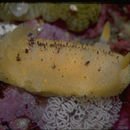en
names in breadcrumbs


Archidoris montereyensis is abundant in its natural environment and since they have no value to humans, they are not affected by human exploitation. Haliclona spp., its favorite food also is not used by man and therefore would not be a factor in its conservation (Jeffords 2000).
US Federal List: no special status
CITES: no special status
Unknown
Small numbers are taken for research. Their limited diet causes them to die quickly in an aquarium. Therefore, they are not sought after as pets. This is also true for other nudibranchs (Jeffords 2000).
Like all other nudibranchs, Archidoris montereyensis is carnivorous and selective in what it eats. Archidoris montereyensis preys on encrusting sponges such as Haliclona spp. It uses its radula to scrape the sponge off of the substrate and then ingest it. Unlike many dorid nudibranchs, Archidoris montereyensis cannot store the toxins of its prey. It is possible though that he mimics other dorids that have that ability (Picton 1994, Cook 1962).
Archidoris montereyensis is most commonly found along the West Coast of North America. It ranges from Kachemak Bay, Alaska to San Diego, California. It is most common in Monterey Bay, California: the locality it derives its name from (Miller 1999, Jeffords 2000).
Biogeographic Regions: pacific ocean (Native )
Archidoris montereyensis lives exclusively in the ocean. Their inability to withstand desiccation limits them to the marine environment. They are located in the subtidal and low- intertidal zones (tidepools) along the West Coast of North America. Archidoris montereyensis is most common in areas where there is a healthy population of sponges such as reefs and/or areas that provide ample shade (Miller 1999, Jeffords 2000).
Aquatic Biomes: coastal
Archidoris montereyensis averages about 45 mm in length but may reach an extreme of about 150 mm. The body is rounded and has a thick, fleshy mantle that extends over the body. As is true with all nudibranchs, they have no shell. Like most dorids, Archidoris is short and fat. Its coloration is primarily yellow with dark spots. It is these spots that distinguish it from a close relative that is also commonly known as the Sea Lemon Nudibranch. The number of these spots range from only a few to almost solid and varies by specimen. This drab yellow / dark spots combination offers camouflage and classifies Archidoris as a cryptobranch (cryptic). In contrast, brightly colored, obvious nudibranchs are called aposematic. At their anterior end, they have sensory organs called rhinophores that look like little horns on top of their heads . These rhinophores contain many chemoreceptors that the sea slug uses to locate food and each other. Their posterior end contains the exposed, delicate gill plume that is composed of 7 branchial plumes. This is the origin of the name "nudibranch" (naked gill). Archidoris uses its foot to move just like all other gastropods (Miller 1999, Picton 1994).
Range mass: 0 to 0 kg.
Other Physical Features: ectothermic ; bilateral symmetry
Just like all other nudibranchs, Archidoris montereyensis is hermaphroditic, meaning that each specimen possesses both the male and the female sex organs. When nudibranchs mate, they join together and pass sperm to each other through a common opening on the side of their bodies. Fertilization occurs internally and in Archidoris montereyensis, the eggs are laid in rose-like masses that are typical of dorid nudibranchs. Egg laying in A. montereyensis is triggered by a discrete set of neuroendocrine cells. After an incubation period that can last up to 50 days, but is generally much shorter, the larvae are hatched. These larvae eventually change into adults. It is possible that this metamorphosis is triggered by the presence of it preferred prey species. The life span of Archidoris montereyensis is about 1 year, or perhaps a little longer(Wiens 1992, Jeffords 2000).
Doris montereyensis is a species of sea slug, a dorid nudibranch, a shell-less marine gastropod mollusk in the family Dorididae.[2]
Doris montereyensis is similar in shape and colour to Anisodoris nobilis but instead of the gills being white they are yellow which is the same as the mantle. Dark pigment usually covers the tubercles.[3]
This species has been recorded from Alaska to San Diego, California.[3]
![]() Media related to Doris montereyensis at Wikimedia Commons
Media related to Doris montereyensis at Wikimedia Commons
Doris montereyensis is a species of sea slug, a dorid nudibranch, a shell-less marine gastropod mollusk in the family Dorididae.